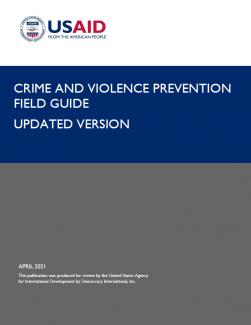USAID’s Bureau for Latin America and the Caribbean (LAC Bureau) has long been at the forefront of addressing citizen security issues. In the 1980s, the LAC Bureau and its field missions developed some of USAID’s first judicial reform programs. Today, citizen security-related issues have become central to USAID’s work in many countries. Programs address a range of issues, from gang and drug trafficking-related crime in LAC to violent extremism, community stabilization, and core rule of law in post-conflict countries in the Middle East, South Asia, and Africa. Although USAID works on the full gamut of citizen security issues, from rule of law/security sector reform to community-based youth crime and violence prevention, this Field Guide focuses just on prevention - which is one component of a comprehensive citizen security program.
Citizen insecurity negatively affects development and at the same time is driven by underdevelopment. Poor workforce development, limited employment opportunities, underperforming schools, poor family planning, lack of adequate access to and quality of public health and social services, and weak justice systems can all contribute to crime and insecurity. Although democracy and governance specialists often lead citizen security programming, cross-sectoral approaches are needed to address multicausal drivers and risk factors for crime and violence, bringing in education, health, and economic growth, amongst others. This is especially urgent considering that criminal activity is responsible for many more deaths and disabilities worldwide than armed conflict and terrorism. Crime and violence also take a significant toll on the overall development of a country. The Inter-American Development Bank (IDB) estimates that the direct costs of crime and violence (largely medical care and the judicial and penal system) represent an average of 3.5 percent of GDP, with indirect costs (e.g., lost wages and psychological costs) raising this figure further.
After years of heavy-handed responses to crime and violence—the iron-fisted or mano dura approach—many governments in the LAC region have recognized (even if only rhetorically) that a solely punitive and reactive law enforcement response to crime and violence is insufficient and, ultimately, ineffective in reducing violent crime. A more comprehensive approach to citizen security must include prevention efforts that address the factors that lead to crime and violence in the first place. This entails working not only with governments but also with civil society organizations, schools, the health sector, the business community, the most important communication outlets, and the academic community. Crime and violence prevention, as an important contribution to crime reduction, is a much more effective and sustainable approach that is—also—less expensive than reactive law enforcement and incarceration.
This Field Guide is designed to support USAID officers and other practitioners working on citizen security and violence prevention by providing a conceptual framework for understanding crime, violence, and prevention as part of broader citizen security systems; information about evidence-based interventions to prevent crime and violence; and practical advice and tools on how to design, implement, measure, and evaluate projects that address crime and violence or citizen security. USAID’s LAC Bureau first produced this Field Guide in 2016 and the current 2021 version highlights many examples from the LAC region. Yet, most of the rigorous evidence on effective violence prevention interventions comes from developed countries, particularly the United States and the United Kingdom, and the impacts of the adaptations to LAC contexts are not fully understood or tested. Nonetheless, the strategies and suggestions included in this guide are applicable to a wide range of contexts and can be used by stakeholders working on crime and violence prevention across the world.

